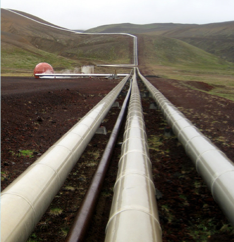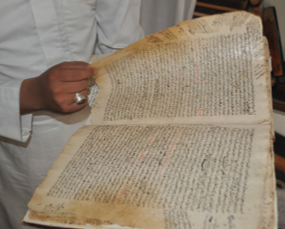
In science, as in life, sometimes discovery is about unintended consequences -- as UO geologists Mark Reed and James Palandri found out on a project in Iceland.
Reed and Palandri, taking part in a deep- drilling project in Iceland’s Krafla volcano, were surprised when magma (underground lava) gushed into their well. Normally, magma lies in pools more than ten kilometers (32,800 feet) below the surface, but this inflow occurred at a depth of about two kilometers (about 6,500 feet).

Hot water and steam pipes leading from a geothermal wellhead in Iceland. Ninety-five percent of home heating in Iceland is produced from volcanic sources.
As a result, their original project— an effort to plumb the depths of the Earth for high-temperature, high-density, low-viscosity water, so-called supercritical water, for use as a potential source of geothermal power—had to be put on hold. But an intriguing new possibility had presented itself: Can the extremely high pressures and temperatures of magma be exploited as a source of electrical energy?
The interruption presented the team with a unique opportunity to ponder the possibilities of a new and especially hot geothermal system as an energy source.
Today, one-third of the electric power and 95 percent of home heating in Iceland is produced from naturally occurring steam and hot water inside volcanic rocks. The higher the temperature and pressure of underground water and steam, the more cost-efficient it is to generate electric power from these naturally occurring resources.
During the research group’s drilling, magma began flowing into the well at a depth of 2.1 kilometers, filling the bottom nine meters of the hole. When the well was tested, high-pressure 375°C (700°F) steam rose to the surface. If passed through a turbine at the flow rates of the well during tests, such hot, dry steam could generate 25 megawatts of electricity, enough to power 25,000 to 30,000 homes. Typical geothermal wells produce 5 to 8 megawatts of electricity.
The group—whose research is part of the Iceland Deep Drilling Project, a government-industry scientific research consortium—suspects that similarly shallow pools of magma exist elsewhere in the world, wherever young volcanic rocks are found. These pools, when located, could become reliable sources of high- grade energy. The group plans to begin drilling a new well in southwest Iceland in 2013 to explore this possibility.
The original research was funded by a $3.5 million grant from the National Science Foundation and a $1.5 million grant from the International Continental Scientific Drilling Program.
—Eric Tucker
Photo by Mark Reed




 Watch
Watch  Watch excerpts from the opera, coming soon to Eugene.
Watch excerpts from the opera, coming soon to Eugene. 

 Three’s a charm for a living memorial.
Three’s a charm for a living memorial.